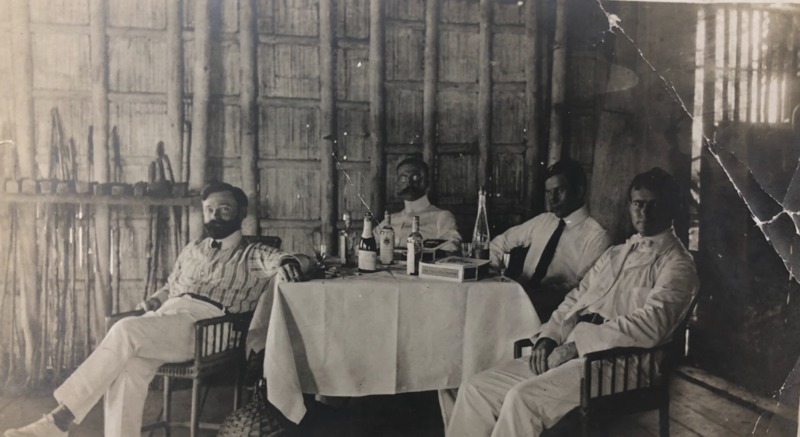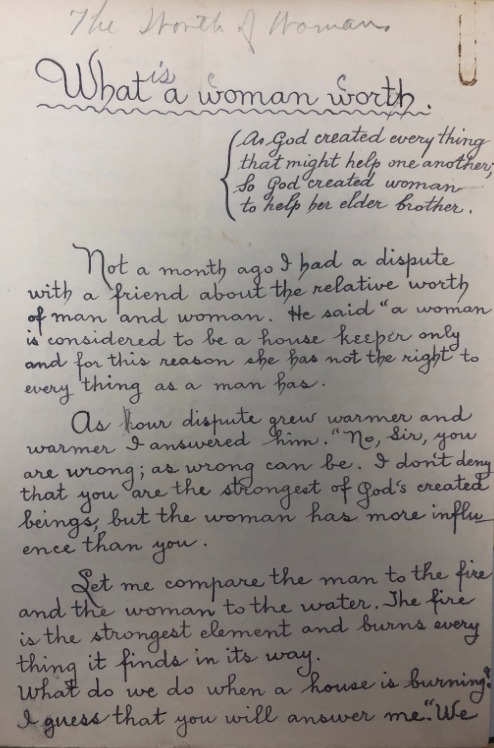Frederick G. Behner's "Thomasite Adventure"
Early Life of Frederick George Behner
Frederick George Behner was one of the original Thomasites aboard the USAT Thomas. He was born on a farm in Northwestern Ohio in 1874 and was raised in a Christian family. His father died shortly after his birth, and his stepfather did not permit him to attend school. He was required to work in the fields beginning at age seven.[1] However, he eventually found an outlet in the Evangelical church and taught himself to read and write. At the age of 16, he passed a teacher’s examination and began work as a Sunday school teacher. He also earned money by selling fruit and books on the side of the road. After saving up enough money, Behner sent himself to North Central College in Naperville, Illinois where he graduated valedictorian of his class in 1900.
After graduation, Behner was selected to be Inspector of Schools for the United States government in the Philippine Islands. From Ohio, he made the journey to Romblon Province, Philippines, where he taught from 1901 to 1905. Many of the Thomasites became quite good friends as a result of their post. They frequently enjoyed a smoke or a drink together after a day of work at school. Although Frederick Behner’s time in the Philippines was just a short part of his life, he kept a diary that reveals important insights into how his teaching influenced his students in the Philippines.
A Civilizing Mission
Behner kept a detailed diary of his time in the Philippines, which offers perspective on his broader vision of colonial education. His daughter later transcribed his diary entries into an unpublished book entitled One Man's Journey to the Philippine Islands: The Thomasite Adventure. According to the prologue,
The goal of the United States government was to establish a free democracy in the islands through education…In addition, the Thomasite teachers were also given the responsibility of training native Filipino teachers to broaden the educational opportunities of the children.[2]
As this passage reveals, Behner saw his mission as a colonial educator to be an important one in supporting the broader goal of the US government. Thomasites such as Behner did not see themselves solely as educators of children, but as a critical part of the colonial project as vessels of American democracy.
Behner’s vision of instilling American values in Filipino children is evident in the lessons that he designed for his students. By examining the examples of student work that Behner kept, we can map out his tailored curriculum. One of his students, Rufina Alma, wrote an an essay on the importance of education. She stated, “We have so many pupils that come from other towns to attend our school to be civilized because uncivilization is the worst thing that a person could be [3]." As evidenced in Alma’s essay, the Thomasites’ curriculum centered around changing the Filipino’s self-perception and inculcating notions of the new, superior, “civilized” order. One of the lessons that Alma learned in Behner’s classroom was that the Filipino population was uncivilized and inherently inferior. Although this essay was written by a Filipina, we have to question whether or not it was a piece written entirely by free will. Many of the student essays in Behner’s collection focused on topics such as honesty, duty, and democratic politics, indicating the Thomasite dedication to value-based education.
Gender in Behner’s Christian Lessons
Behner’s curriculum did not only focus on instilling democratic values, but also emphasized American gender norms through religious teachings. One student named Feliza San Agustina wrote an essay entitled “What is a Woman Worth,” in 1904.[4] She recounted a debate she had with a male classmate who exclaimed that women served no value to society. Feliza passionately refuted this claim, arguing that men would be nothing without women. She cited the biblical tale of Adam and Eve, no doubt influenced by Frederick G. Behner’s Christian lessons as he often had students write essays on the value of churches. Feliza explained that women were important because they aided men, which included raising their children and attending to the needs of the family. In his co-educational classroom, Mr. Behner clearly enforced a gender hierarchy in his teaching.
A Well-Rounded Western Education
Many lessons and assignments were centered around assimilating Filipinos into American culture and Western frames of knowledge. Behner’s classroom focused on liberal arts subjects commonly taught in the US such as science, geography, arithmetic, creative writing, history, philosophy, and more.[5] For example, their lessons in US history emphasized the importance of Marquis de Lafayette to the American Revolution. For science, Behner’s students wrote essays on the sun and the process of plant fertilization. The geography lessons that Behner designed asked students to hand-draw maps of the world and focused mainly on North America. Behner furthermore challenged students by exposing them to Western philosophy, having them answer questions such as “What is time?” and “What is worth?” To get students to think creatively and develop their writing skills, Behner asked students to practice making up stories. Behner kept copies of student creative essays, which show multiple revisions of student work as a method of teaching writing. While engaging his students through the teaching methods and knowledge that he knew, Behner’s curriculum undoubtedly contributed to the Americanization of the Philippine population.
Life After the Philippines
Frederick G. Behner concluded his teaching position in the spring of 1905 and traveled to some 30 countries before returning to the United States to join the ministry. He became a pastor in Stockbridge, Michigan and retired after 50+ years in the ministry. He married twice, and had three children, one of whom wrote the biography from which this information is sourced.[6]
Citations
[1] Frederick G. Behner papers, 1893-1924, Box 1, Folder: Biographical Information, Bentley Historical Library, University of Michigan.
[2] Frederick G. Behner papers, 1893-1924, Box 1, Book: One Man's Journey to the Philippine Islands: The Thomasite Adventure, Bentley Historical Library, University of Michigan.
[3] Frederick G. Behner papers, 1893-1924, Box 1, Folder: Student Papers 1 of 9, Bentley Historical Library, University of Michigan.
[4] Frederick G. Behner papers, 1893-1924, Box 1, Folder: Student Papers 3 of 9, Bentley Historical Library, University of Michigan.
[5] Frederick G. Behner papers, 1893-1924, Box 1, Folder: Student Papers 1-9, Bentley Historical Library, University of Michigan.
[6] Frederick G. Behner papers, 1893-1924, Box 1, Folder: Biographical Information, Bentley Historical Library, University of Michigan.




